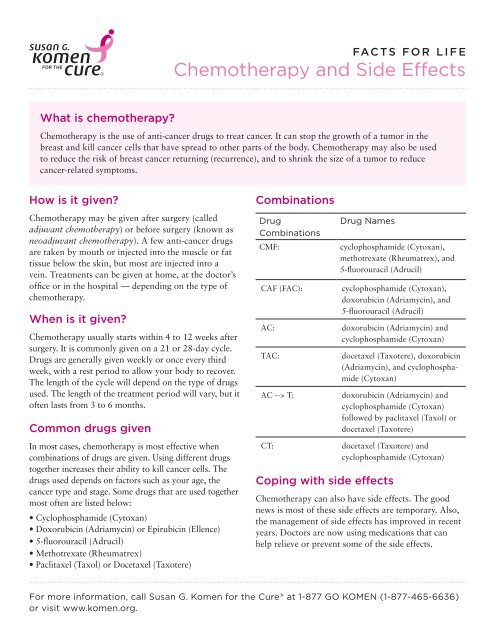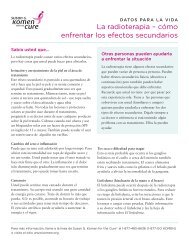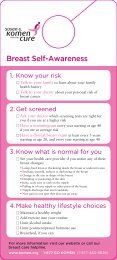Chemotherapy and Side Effects - Susan G. Komen for the Cure
Chemotherapy and Side Effects - Susan G. Komen for the Cure
Chemotherapy and Side Effects - Susan G. Komen for the Cure
You also want an ePaper? Increase the reach of your titles
YUMPU automatically turns print PDFs into web optimized ePapers that Google loves.
FACTS FOR LIFE<br />
<strong>Chemo<strong>the</strong>rapy</strong> <strong>and</strong> <strong>Side</strong> <strong>Effects</strong><br />
What is chemo<strong>the</strong>rapy?<br />
<strong>Chemo<strong>the</strong>rapy</strong> is <strong>the</strong> use of anti-cancer drugs to treat cancer. It can stop <strong>the</strong> growth of a tumor in <strong>the</strong><br />
breast <strong>and</strong> kill cancer cells that have spread to o<strong>the</strong>r parts of <strong>the</strong> body. <strong>Chemo<strong>the</strong>rapy</strong> may also be used<br />
to reduce <strong>the</strong> risk of breast cancer returning (recurrence), <strong>and</strong> to shrink <strong>the</strong> size of a tumor to reduce<br />
cancer-related symptoms.<br />
How is it given?<br />
<strong>Chemo<strong>the</strong>rapy</strong> may be given after surgery (called<br />
adjuvant chemo<strong>the</strong>rapy) or be<strong>for</strong>e surgery (known as<br />
neoadjuvant chemo<strong>the</strong>rapy). A few anti-cancer drugs<br />
are taken by mouth or injected into <strong>the</strong> muscle or fat<br />
tissue below <strong>the</strong> skin, but most are injected into a<br />
vein. Treatments can be given at home, at <strong>the</strong> doctor’s<br />
office or in <strong>the</strong> hospital — depending on <strong>the</strong> type of<br />
chemo<strong>the</strong>rapy.<br />
When is it given?<br />
<strong>Chemo<strong>the</strong>rapy</strong> usually starts within 4 to 12 weeks after<br />
surgery. It is commonly given on a 21 or 28-day cycle.<br />
Drugs are generally given weekly or once every third<br />
week, with a rest period to allow your body to recover.<br />
The length of <strong>the</strong> cycle will depend on <strong>the</strong> type of drugs<br />
used. The length of <strong>the</strong> treatment period will vary, but it<br />
often lasts from 3 to 6 months.<br />
Common drugs given<br />
In most cases, chemo<strong>the</strong>rapy is most effective when<br />
combinations of drugs are given. Using different drugs<br />
toge<strong>the</strong>r increases <strong>the</strong>ir ability to kill cancer cells. The<br />
drugs used depends on factors such as your age, <strong>the</strong><br />
cancer type <strong>and</strong> stage. Some drugs that are used toge<strong>the</strong>r<br />
most often are listed below:<br />
• Cyclophosphamide (Cytoxan)<br />
• Doxorubicin (Adriamycin) or Epirubicin (Ellence)<br />
• 5-fluorouracil (Adrucil)<br />
• Methotrexate (Rheumatrex)<br />
• Paclitaxel (Taxol) or Docetaxel (Taxotere)<br />
Combinations<br />
Drug<br />
Combinations<br />
CMF:<br />
CAF (FAC):<br />
AC:<br />
TAC:<br />
AC --> T:<br />
CT:<br />
Drug Names<br />
cyclophosphamide (Cytoxan),<br />
methotrexate (Rheumatrex), <strong>and</strong><br />
5-fluorouracil (Adrucil)<br />
cyclophosphamide (Cytoxan),<br />
doxorubicin (Adriamycin), <strong>and</strong><br />
5-fluorouracil (Adrucil)<br />
doxorubicin (Adriamycin) <strong>and</strong><br />
cyclophosphamide (Cytoxan)<br />
docetaxel (Taxotere), doxorubicin<br />
(Adriamycin), <strong>and</strong> cyclophosphamide<br />
(Cytoxan)<br />
doxorubicin (Adriamycin) <strong>and</strong><br />
cyclophosphamide (Cytoxan)<br />
followed by paclitaxel (Taxol) or<br />
docetaxel (Taxotere)<br />
docetaxel (Taxotere) <strong>and</strong><br />
cyclophosphamide (Cytoxan)<br />
Coping with side effects<br />
<strong>Chemo<strong>the</strong>rapy</strong> can also have side effects. The good<br />
news is most of <strong>the</strong>se side effects are temporary. Also,<br />
<strong>the</strong> management of side effects has improved in recent<br />
years. Doctors are now using medications that can<br />
help relieve or prevent some of <strong>the</strong> side effects.<br />
For more in<strong>for</strong>mation, call <strong>Susan</strong> G. <strong>Komen</strong> <strong>for</strong> <strong>the</strong> <strong>Cure</strong> ® at 1-877 GO KOMEN (1-877-465-6636)<br />
or visit www.komen.org.
Common side effects<br />
<strong>Side</strong> effects from chemo<strong>the</strong>rapy depend on <strong>the</strong> drug<br />
or combination of drugs used. <strong>Side</strong> effects vary from<br />
person to person. Some of <strong>the</strong> most common side<br />
effects are described below.<br />
Nausea <strong>and</strong> vomiting<br />
Drugs called antiemetics can help reduce or prevent<br />
nausea <strong>and</strong> vomiting that can occur during chemo<strong>the</strong>rapy.<br />
Eating several small meals throughout <strong>the</strong><br />
day may also help.<br />
Hair loss (alopecia)<br />
During treatment, your hair may get thinner or may<br />
fall out entirely, depending on which chemo<strong>the</strong>rapy<br />
drugs you are given. You may also have hair loss from<br />
your eyebrows, eyelashes <strong>and</strong> body. Your hair will<br />
grow back after treatment ends, but it may be a<br />
different color or texture. Using mild shampoos, soft<br />
hair brushes <strong>and</strong> low heat when drying your hair may<br />
help reduce hair loss. Some women may choose to cut<br />
<strong>the</strong>ir hair short be<strong>for</strong>eh<strong>and</strong> to gain some control. If<br />
you would like to wear a wig, it is a good idea to get it<br />
be<strong>for</strong>e treatment begins so you can match your hair<br />
color <strong>and</strong> style.<br />
Early menopause (when your menstrual period stops)<br />
Some women may have menopausal symptoms such<br />
as <strong>the</strong>ir menstrual periods stopping, hot flashes <strong>and</strong><br />
vaginal dryness during treatment. For women who<br />
are closer to <strong>the</strong> age of menopause (45 years or older),<br />
<strong>the</strong>se symptoms may be permanent. For younger<br />
women, <strong>the</strong>se symptoms may be temporary. Your<br />
doctor can help you manage <strong>the</strong>se symptoms.<br />
Fatigue<br />
This is a common side effect. Try to get plenty of rest<br />
<strong>and</strong> ask family <strong>and</strong> friends to help. Exercise <strong>and</strong> a<br />
well-balanced diet may also help. Your doctor may<br />
also use a medication that may reduce fatigue.<br />
Infections<br />
Because chemo<strong>the</strong>rapy reduces <strong>the</strong> white blood cell<br />
count, infections are more likely to occur. You can help<br />
prevent infections by washing your h<strong>and</strong>s often <strong>and</strong><br />
staying away from o<strong>the</strong>rs who are ill. If you get a cut or<br />
nick, clean it right away. Your doctor should check your<br />
blood cell count be<strong>for</strong>e each treatment to make sure<br />
it is high enough to safely give you chemo<strong>the</strong>rapy.<br />
If you have any sign of infection such as fever while<br />
on chemo<strong>the</strong>rapy, you should contact your doctor<br />
right away.<br />
Mouth <strong>and</strong> throat sores<br />
Because <strong>the</strong> cells in <strong>the</strong> mouth <strong>and</strong> throat are fastgrowing,<br />
some chemo<strong>the</strong>rapy drugs affect <strong>the</strong>se areas<br />
causing sores or dryness. Get a dental check-up be<strong>for</strong>e<br />
starting chemo<strong>the</strong>rapy. During treatment, brush your<br />
teeth <strong>and</strong> gums after each meal <strong>and</strong> at bedtime using a<br />
soft toothbrush. Using a toothpaste with baking soda<br />
<strong>and</strong> peroxide can also help. Avoid mouthwashes that<br />
contain large amounts of alcohol.<br />
Weight gain<br />
Although <strong>the</strong> reasons are unclear, some women gain<br />
weight during chemo<strong>the</strong>rapy. Eating nutritious food<br />
<strong>and</strong> exercising can help maintain your normal weight.<br />
Nail weakness<br />
Some treatments can cause damage to <strong>the</strong> fingernails<br />
<strong>and</strong> toenails. The nails become brittle <strong>and</strong> sore,<br />
<strong>and</strong> may fall off. Like hair loss, nail problems are<br />
temporary.<br />
Memory problems (chemo-brain)<br />
<strong>Chemo<strong>the</strong>rapy</strong> may lead to a general sense of mental<br />
fuzziness <strong>and</strong> short term memory problems. Most<br />
women say that <strong>the</strong>se symptoms improve with time.<br />
Resources<br />
<strong>Susan</strong> G. <strong>Komen</strong> <strong>for</strong> <strong>the</strong> <strong>Cure</strong> ®<br />
1-877 GO KOMEN (1-877-465-6636), www.komen.org<br />
Questions to Ask <strong>the</strong> Doctor<br />
www.komen.org/questions<br />
American Cancer Society<br />
1-800-ACS-2345, www.cancer.org<br />
National Cancer Institute<br />
Related fact sheets in this series:<br />
1-800-4-CANCER, www.cancer.gov<br />
• Clinical Trials<br />
• Getting <strong>the</strong> Support You Need<br />
• Making Treatment Decisions<br />
The above list of resources is only a suggested resource <strong>and</strong> is not a complete listing of breast health <strong>and</strong> breast cancer materials or in<strong>for</strong>mation. The in<strong>for</strong>mation contained herein is not<br />
meant to be used <strong>for</strong> self-diagnosis or to replace <strong>the</strong> services of a medical professional. <strong>Komen</strong> <strong>for</strong> <strong>the</strong> <strong>Cure</strong> does not endorse, recommend or make any warranties or representations<br />
regarding <strong>the</strong> accuracy, completeness, timeliness, quality or non-infringement of any of <strong>the</strong> materials, products or in<strong>for</strong>mation provided by <strong>the</strong> organizations referenced herein.<br />
Developed in collaboration with <strong>the</strong> Health Communication Research Laboratory at Saint Louis University. ©2009 <strong>Susan</strong> G. <strong>Komen</strong> <strong>for</strong> <strong>the</strong> <strong>Cure</strong>. Item No. KOMEED082000 10/09








